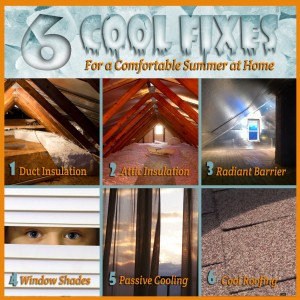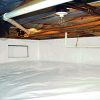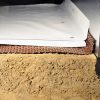There’s no need to sweat because of hot weather and high air conditioning expenses
Summer heat is here. What could be worse than sweating all night long in an upstairs bedroom that your air conditioning system can’t seem to reach? How about being shocked by a huge spike in your electric bill because of prolonged AC operation? Unfortunately, many homeowners have to deal with this combination of physical and financial discomfort when hot weather arrives. The good news is that these ailments are treatable. The different strategies discussed below will all help to reduce demands on your AC system. You may not be able to put all these measures into play, but even a few can make a big difference.

1. Insulate attic ductwork.
Do you have ductwork in your attic? If so, radiant heat from your roof shingles can easily bring attic (and attic ductwork) temperatures into the 120-degree range. Blowing cooled air from your AC system through hot ducts sounds ridiculously inefficient. It is. Your AC system will actually need to cool your ductwork before it can effectively deliver cool air to your living space. The solution to this problem is duct insulation. Different types of ducts call for different insulation strategies, so make sure to call in an experienced contractor.
2. Upgrade attic insulation.
This cool-enhancing upgrade is easy to appreciate. Heat always travels from more to less, which means that the really hot temperature in a summer attic will want to move toward the cooler living space. Increasing the amount of insulation in your attic will slow this heat transfer. Visit the ENERGY STAR website to see what level of attic insulation is recommended in your climate zone. There are two bonuses to this improvement. First of all, by blowing a thicker layer of insulation into your attic, you may cover most of your existing ductwork, eliminating the need to insulate attic ductwork in a separate operation. Secondly, this thicker thermal boundary will make you much more comfortable in wintertime, while also reducing your heating bills.
3. Install an attic radiant barrier.
Insulation will effectively slow heat movement by conduction. Installing a radiant barrier in your attic will slow heat movement by radiation. The most common type of attic radiant barrier is a foil-faced plastic sheet that is usually stapled along the underside of attic rafters. It works just like the shiny windshield screens that people use to prevent parked cars from overheating. A radiant barrier is an excellent supplement to an attic insulation upgrade, but it’s not a substitute for attic insulation.
4. Shade your windows.
“Direct heat gain” is what happens when sunlight penetrates into the house through windows, turning sunlit objects and materials into large radiators. Although the reflective coatings used on low-e window glass can lessen this heat gain, it’s even more effective to block direct gain by shading windows. This can be done in a number of ways –with window shades, blinds, awnings, or window shutters.
5. Use passive cooling techniques.
It’s smart to “manage” your home’s temperature with passive cooling strategies that will cut your AC expenses. When evenings bring cooler temperatures, turn off the AC system and open windows so that cooler air can enter the house. Opening your windows will also take advantage of natural breezes that have a cooling effect. You can keep windows open until temperatures begin to rise the next morning. If your home has lower windows that are shaded by a porch roof, try turning off the AC system and opening the porch windows and upstairs windows, too. You’ll be creating a breeze indoors as hot air rises and escapes through upper windows, drawing in cooler air through lower windows.
6. Install a cool roof.
If your home needs new roof shingles, ask your roofing contractor to install ENERGY STAR® rated roof shingles designed to absorb less solar energy. Available from all major manufacturers of asphalt-fiberglass shingles, “cool” roof shingles utilize granules that have a more reflective coating to reduce heat gain. Alternatively, you could install an ENERGY STAR® rated metal roof with similar heat-reflecting qualities. Research has shown that taking advantage of cool roof technology can reduce your cooling expenses by 7% – 15%.
Here’s a video from Larry Janesky’s Dr. Energy Saver that will help you learn more about cool roof technology.






